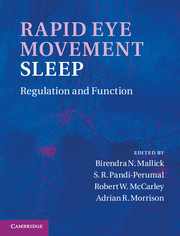Book contents
- Frontmatter
- Contents
- Contributors
- Preface
- Acknowledgments
- Organization
- Section I Historical context
- Section II General biology
- Section III Neuronal regulation
- 10 Understanding REM sleep: clues from brain lesion studies
- 11 Preoptic and basal forebrain modulation of REM sleep
- 12 Amygdalar regulation of REM sleep
- 13 Pontomedullary mediated REM-sleep atonia
- 14 Phenomenology and function of myoclonic twitching in developing rats
- 15 Pontine-wave generator: a key player in REM sleep-dependent memory consolidation
- 16 Hippocampal theta rhythm of REM sleep
- 17 Respiration during REM sleep and its regulation
- 18 Modulation of REM sleep by non-REM sleep and waking areas in the brain
- Section IV Neuroanatomy and neurochemistry
- Section V Functional significance
- Section VI Disturbance in the REM sleep-generating mechanism
- Index
- Plate section
- References
16 - Hippocampal theta rhythm of REM sleep
from Section III - Neuronal regulation
Published online by Cambridge University Press: 07 September 2011
- Frontmatter
- Contents
- Contributors
- Preface
- Acknowledgments
- Organization
- Section I Historical context
- Section II General biology
- Section III Neuronal regulation
- 10 Understanding REM sleep: clues from brain lesion studies
- 11 Preoptic and basal forebrain modulation of REM sleep
- 12 Amygdalar regulation of REM sleep
- 13 Pontomedullary mediated REM-sleep atonia
- 14 Phenomenology and function of myoclonic twitching in developing rats
- 15 Pontine-wave generator: a key player in REM sleep-dependent memory consolidation
- 16 Hippocampal theta rhythm of REM sleep
- 17 Respiration during REM sleep and its regulation
- 18 Modulation of REM sleep by non-REM sleep and waking areas in the brain
- Section IV Neuroanatomy and neurochemistry
- Section V Functional significance
- Section VI Disturbance in the REM sleep-generating mechanism
- Index
- Plate section
- References
Summary
Summary
The theta rhythm of the hippocampus is a large- amplitude (1–2 mV), nearly sinusoidal oscillation of 5 to 12 Hz. Theta is present in the hippocampus of the rat during the exploratory movements of waking and continuously throughout REM sleep. In early reports, we identified neurons of the nucleus pontis oralis (RPO) of the pons that discharged in association with the theta of waking and REM sleep, and subsequently showed that electrical stimulation or carbachol injections into the RPO very effectively elicited theta. These findings indicated that RPO was the brain-stem source for the generation of theta. In related studies, we described an ascending RPO to septohippocampal system routed through the hypothalamic supramammillary nucleus controlling theta, and further demonstrated that the serotonin-containing median raphe (MR) nucleus desynchronized the hippocampal EEG – or blocked theta. The latter indicates that theta, like other events of REM sleep, is subject to aminergic modulation; that is, the suppression of MR activity during REM releases theta in that state. Theta serves a well recognized role in memory processing in waking. We suggest that theta does not serve the same function in REM sleep (memory processing), but rather theta (of REM) is a by-product of the intense forebrain activation of REM sleep, which serves the important function of maintaining the minimum requisite levels of activity periodically throughout sleep to ensure and promote recovery from sleep.
- Type
- Chapter
- Information
- Rapid Eye Movement SleepRegulation and Function, pp. 151 - 163Publisher: Cambridge University PressPrint publication year: 2011
References
- 1
- Cited by

